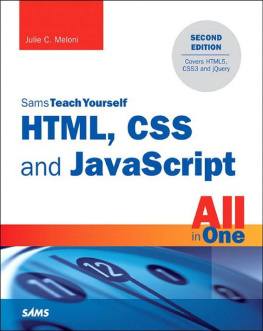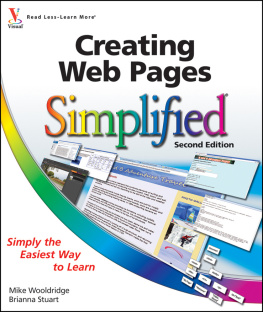Learning Web Design, 3rd Edition
A Beginners Guide to (X)HTML, Style Sheets, and Web Graphics
Everything you need to know to create professional web sites is right here. Learning Web Design starts from the beginningdefining how the Web and web pages workand builds from there. By the end of the book, youll have the skills to create multi-column CSS layouts with optimized graphic files, and youll know how to get your pages up on the Web.
This thoroughly revised edition teaches you how to build web sites according to modern design practices and professional standards.
The book includes exercises to help you to learn various techniques, and short quizzes to make sure youre up to speed with key concepts. If youre interested in web design, Learning Web Design is the place to start.
This book explains:
- How to create a simple (X)HTML page and add links and images
- Everything you need to know about web standards(X)HTML, DTDs, and more
- Cascading Style Sheetsformatting text, colors and backgrounds, using the box model, page layout, and more
- All about web graphics, and how to make them lean and mean through optimization
- The site development process, from start to finish
- Getting your pages on the Webhosting, domain names, and FTP
About the author
Jennifer Niederst Robbins has 14 years of web design experience, as both a designer and a teacher, having designed the first commercial web site, OReillys Global Network Navigator (GNN), in 1993. Shes the author of OReillys bestselling Web Design in a Nutshell, and has taught web design at the Massachusetts College of Art in Boston and Johnson and Wales University in Providence, Rhode Island.
Learning Web Design
Learning Web Design
Third Edition
A Beginners Guide to (X)HTML, Style Sheets, and Web Graphics
Jennifer Niederst Robbins
Learning Web Design, Third Edition
A Beginners Guide to (X)HTML, Style Sheets, and Web Graphics
by Jennifer Niederst Robbins
Copyright 2007 OReilly Media, Inc. All rights reserved. Printed in Canada.
Published by OReilly Media, Inc., 1005 Gravenstein Highway North, Sebastopol, CA 95472.
OReilly Media books may be purchased for educational, business, or sales promotional use. Online editions are also available for most titles (safari.oreilly.com). For more information, contact our corporate/institutional sales department: 800-998-9938 or .
Editor: Linda Laflamme
Production Editor: Philip Dangler
Cover Designer: Mark Paglietti
Interior Designer: Ron Bilodeau
Print History:
March 2001: First edition.
June 2003: Second edition.
June 2007: Third edition.
The OReilly logo is a registered trademark of OReilly Media, Inc. OReilly Digital Studio and related trade dress are trademarks of OReillyMedia, Inc. Photoshop, Illustrator, Dreamweaver, Elements, HomeSite, and Fireworks are either registered trademarks or trademarks of Adobe Systems Incorporated in the United States and/or other countries. Microsoft and Expression Web are either registered trademarks or trademarks of Microsoft Corporation in the United States and/or other countries. Many of the designations used by manufacturers and sellers to distinguish their products are claimed as trademarks. Where those designations appear in this book, and OReillyMedia, Inc. was aware of a trademark claim, the designations have been printed in caps or initial caps.
While every precaution has been taken in the preparation of this book, the publisher and author assume no responsibility for errors or omissions, or for damages resulting from the use of the information contained herein.
This book uses RepKover, a durable and flexible lay-flat binding.
ISBN: 978-0-596-52752-5
[TI] [2012-02-24]
PREFACE
Hello and welcome to the third edition of Learning Web Design! When I first started writing it, I figured, Its just an update... Ill just make a few tweaks and it will be done in a jiffy. I couldnt have been more wrong. As it turns out, pretty much everything about web design changed since I wrote the second edition four years ago. Most significantly, web designers as well as browser developers are finally abiding by the standards for writing and styling web pages set forth by the World Wide Web Consortium (W3C). Youll learn a lot more about these standards throughout the book.
What it means is that using HTML markup for visual effects is outHTML for describing the meaning and structure of content is in. Table-based layouts are outstyle sheet-driven layouts are in. And the font element, spacer GIFs, and other clever hacks of the past... forget about it! Theyre all history.
The Companion Web Site
Be sure to visit the companion web site for this book at learningwebdesign.com. It features materials for the exercises, downloadable articles, lists of links from the book, updates, and other good stuff.
This edition has been completely rewritten to be in compliance with the standards and modern web design practices. The markup chapters emphasize using HTML to describe your content accurately, not as a tool for formatting the appearance of text. And now you will find seven chapters on Cascading Style Sheets (CSS), where the second edition had just one.
But like the first two editions, this book addresses the specific needs and concerns of beginners of all backgrounds, including seasoned graphic designers, programmers looking for a more creative outlet, office assistants, recent college graduates, work-at-home moms, and anyone else wanting to learn how to design web sites. Ive done my best to put the experience of sitting in my beginner web design class into a book, with exercises and tests along the way, so you get hands-on experience and can check your progress.
I start at square one, with answers to common beginner questions and an explanation of how the Web works. By the end of the book, youll have the skills necessary to create multicolumn CSS layouts with optimized graphic files, and youll know how to get them on the Web. You can start at the very beginning, or feel free to jump in at any point.
Whether you are reading this book on your own or using it as a companion to a web design course, I hope it gives you a good head start and that you have fun in the process.
Acknowledgments
I want to thank my editors, Brian Sawyer, Chuck Toporek, Linda Laflamme, and Steve Weiss, for their valuable input to this new edition. A special thank you goes to my technical reviewer, Aaron Gustafson, for his expert guidance, generosity, and for keeping on the straight and narrow when it comes to standards compliance.
Thanks also to the others who contributed hands-on time to the creation of this book: Ron Bilodeau for the updated interior design, Rob Romano for the figure production, Chris Reilley for helping me envision some of the more complex figures, Sohaila Abdulali for copyediting, Reg Aubry for writing the index, and everyone else who helped with the project.
Finally, I want to thank my Mom, Dad, brother Liam, and the whole Robbins clan for their inspiration and continued support while I labored to crank out this edition. And it pleases me greatly, Jeff and Arlo, to tell you that I am finally done writing. Thanks for putting up with me being half there.


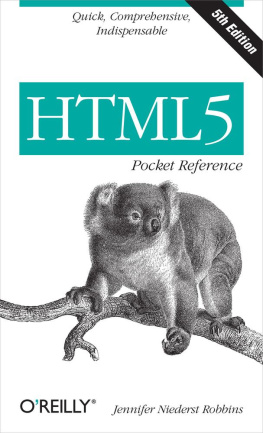
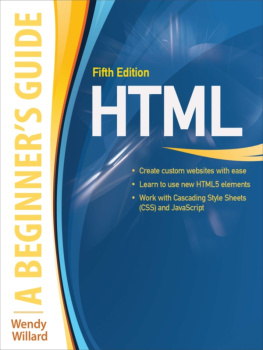
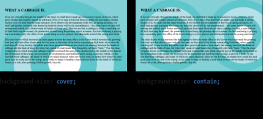
![Julie C. Meloni [Julie C. Meloni] - HTML and CSS in 24 Hours, Sams Teach Yourself (Updated for HTML5 and CSS3) (9th Edition) (Sams Teach Yourself in 24 Hours)](/uploads/posts/book/119155/thumbs/julie-c-meloni-julie-c-meloni-html-and-css-in.jpg)
